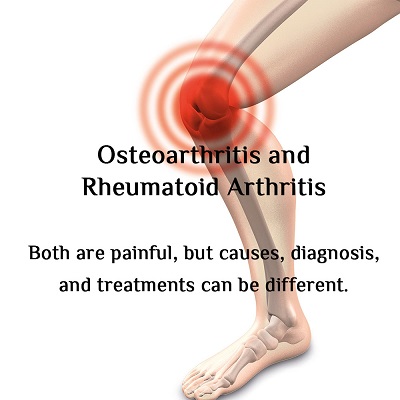 Osteoarthritis (OA) and Rheumatoid Arthritis (RA) are the most common forms of arthritis, characterized by swelling and tenderness of the body’s joints that worsen with age. OA affects more than 30 million Americans, while RA affects about 2 million. These chronic diseases affect the joints and have similar symptoms. However, their causes, diagnosis, and treatments can be different.
Osteoarthritis (OA) and Rheumatoid Arthritis (RA) are the most common forms of arthritis, characterized by swelling and tenderness of the body’s joints that worsen with age. OA affects more than 30 million Americans, while RA affects about 2 million. These chronic diseases affect the joints and have similar symptoms. However, their causes, diagnosis, and treatments can be different.
Similarities and Differences
Osteoarthritis is also called “wear and tear” arthritis or degenerative joint disease. It is caused by the damage of cartilage in the joint due to aging or extraneous physical activities. OA often occurs after the age of 45, particularly in women. It can damage any joint, especially the knees, hands, lower back, and neck.
Rheumatoid arthritis is an autoimmune and inflammatory disease. It occurs when the immune system attacks the joint’s tissues, leading to inflammation, swelling, pain, and stiffness. RA affects not only the joints but other body organs, such as the lungs, heart, and eyes. It occurs more often in women ages 30 to 60.
Symptoms of OA and RA
Rheumatoid arthritis and osteoarthritis have similar symptoms – joint pain, swelling, restricted mobility, and stiffness. Swelling is more severe in RA, and the symptoms are worse in the morning.
There are also differences in their symptoms. For instance, you may experience the symptoms of OA only on one side of the body, while RA occurs on both sides of the body simultaneously, also called a symmetrical pattern of inflammation.
Some symptoms of osteoarthritis include:
- Morning stiffness that usually lasts less than 30 minutes
- Swelling of the affected joint after prolonged rest or inactivity
- A decrease in the range of motion
- Joint pain after a repetitive activity
- Bone spurs or lumps on the joints
Some symptoms of rheumatoid arthritis include:
- Morning stiffness lasting more than an hour
- Excessive fatigue
- Loss of appetite
- Low-grade fever
- Inflammation in other parts of the body, such as the eyes
- A visible lump or rheumatoid nodule on the affected area
- Muscle aches and weakness
Causes of OA and RA
Advanced age is a bigger factor for OA, while RA can happen at any age. However, OA can also occur in younger people who engage in extraneous physical activities or sports or those who have sustained joint injuries.
Common risk factors of osteoarthritis include:
- Increased weight
- Older age
- Family history of osteoarthritis
- Repetitive activity that puts too much stress on the joints
- Joint deformities
- Gout
- Diabetes
The following contribute to the development of rheumatoid arthritis:
- Smoking
- Family history of arthritis
- Obesity
Diagnosis and Treatment
Diagnosis of OA and RA often require physical examinations, lab tests, and X-rays.
Some diagnostic processes to determine osteoarthritis include:
- An imaging test, such as X-rays and MRI (magnetic resonance imaging)
- Blood tests or fluid analysis of the joint
Rheumatoid arthritis can be harder to determine at an early stage, but some tests can help confirm the diagnosis.
Checking for rheumatoid arthritis may involve the following:
- Blood tests that include ESR (erythrocyte sedimentation rate), CRP (C-reactive protein), and Anti-CCP (anti-cyclic citrullinated peptide)
- MRI (magnetic resonance imaging)
Rheumatoid arthritis and osteoarthritis are treated differently, but the focus is the same – reducing joint pain and increasing mobility.
Some medications and treatment for osteoarthritis include:
- Nonsteroidal anti-inflammatory drugs (NSAIDs), such as ibuprofen and naproxen sodium
- Painkillers such as Acetaminophen
- Topical cream or gel
- An antidepressant drug such as Duloxetine
- Therapy
- Surgery
Some treatments and medications for rheumatoid arthritis include:
- NSAIDs
- Disease-modifying anti-rheumatic drugs (DMARDs), such as methotrexate
- Corticosteroids, such as hydrocortisone
- Biologic agents like etanercept, golimumab, infliximab, rituximab
- Therapy
- Surgery, such as synovectomy, joint fusion, and joint replacement
Exercise is helpful to people who have arthritis, improving flexibility and reducing joint pain in the longer term. Maintaining a good weight also improves joint function, and improving your lifestyle and habits can help prevent them from developing or worsening.
Osteoarthritis and rheumatoid arthritis are two common types of arthritis, primarily affecting the joints. While there is no cure for arthritis, medications and treatments can help manage the symptoms, prevent them from getting more severe, and improving your quality of life.
It is important to consult a medical professional if you’re experiencing severe signs of osteoarthritis and rheumatoid arthritis. Proper diagnosis means appropriate treatment plans, and proper medications can be planned and prescribed for you.






